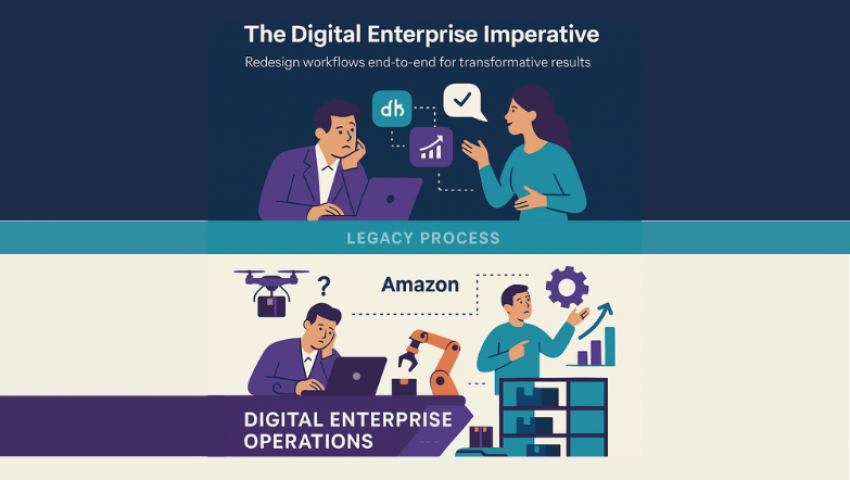
Rethinking Operations: The Digital Enterprise Imperative
Discover why adding AI atop broken processes fails—and how Digital Enterprise Operations (DEO) redesigns workflows end-to-end for transformative results.
This headline sounded familiar: Amazon plans 750,000 warehouse robots and expects $16 billion in annual AI-driven savings by 2032. Yet it didn’t strike us as mere “big tech news.” It felt like replaying a script we’ve misread before.
Companies often throw new tools onto legacy processes and wonder why they don’t stick. Bezos’s team didn’t simply bolt AI onto old workflows. They reimagined every touchpoint—packaging, sorting, delivery—around automation. That deeper reinvention is the missing act for most enterprises chasing digital dreams.
Harvard Business Review reports 70% of digital transformations underperform or outright fail.¹ Most organizations invest in siloed automation, cloud migrations, and AI pilots without rethinking their underlying process architecture.
Standish Group’s CHAOS Report finds that 61% of IT projects exceed budgets or miss objectives, often because new systems bend to ancient workflows rather than prompt workflow evolution.² Simply deploying technology without operational redesign creates more complexity than clarity.
At Maldicore, we champion Digital Enterprise Operations (DEO)—a holistic approach that rewires organizational DNA around digital capabilities. We don’t start with tools; we start with purpose: defining the future-state business you aim to become.
Consider Amazon’s Fulfillment Centers, where robotics, AI, and human labor form a synchronized orchestra. Inventory placement, pick-path optimization, and demand forecasting were redesigned from the ground up, yielding 20% faster throughput and 15% lower operating costs within two years.³
Another example is Zara’s Fast-Fashion Model. Inditex overhauled supplier networks and in-store restocking processes to support rapid design-to-rack cycles. By embedding digital order tracking and automated stocking algorithms, Zara reduced lead time from design to shelf by 50%, capturing trend-driven demand.⁴
Our DEO engagements follow a proven path: diagnose legacy drags, architect future workflows, pilot integrated digital workflows, and scale across the enterprise—ensuring technology and process evolve in lockstep.
Reframe technology conversations with autonomy and vision:
Replace “We need to buy the latest AI platform” with “We choose to redesign our order-to-cash cycle around intelligent automation.”
Shift “Let’s spin up more servers” to “Let’s map our service-delivery bottlenecks and embed cloud elasticity where it matters.”
For example, instead of demanding “We must migrate to SAP S/4HANA immediately,” rephrase as “We opt to pilot a microservices order hub that integrates our best-of-breed tools.” This swap moves the needle from tool obsession to strategic capability building.
Organizations that align process redesign with digital tools report measurable gains:
Manufacturing firms implementing DEO saw cycle-time reductions of 30–40%, slashing lead times by weeks.
Retailers embedding AI into their replenishment workflows reduced stock-outs by 25%, boosting same-store sales by 8%.
Logistics providers that orchestrated robotic sortation with TMS integration cut order-fulfillment costs by 22% and improved on-time delivery rates by 18%.
An exercise for curious leaders: map one core process end to end, identify three digital levers (e.g., AI forecast, robotic picking, cloud orchestration), and estimate potential time or cost savings using industry benchmark ratios.
Week 1–2: Conduct Process Immersion—shadow front-line teams, document existing workflows in value-stream maps.
Week 3–4: Define Future-State Flows—co-create digital-first process blueprints with stakeholders, highlighting AI and automation touchpoints.
Week 5–6: Pilot & Iterate—launch a one-month proof-of-concept in one value stream, measure throughput and error rates.
Week 7–8: Scale & Integrate—roll out across adjacent streams, embed change-management rituals (daily huddles, digital Kanban boards).
Week 9–12: Optimize & Sustain—establish performance dashboards, continuous-improvement loops, and DEO governance structures to lock in gains.
Legacy inertia can derail even the best plans. Guard against analysis paralysis by time-boxing design sprints. Mitigate cultural resistance through frontline “digital champions.” Prevent scope creep by anchoring pilots to explicit ROI thresholds.
Digital transformation isn’t a shopping list—it’s a mindset and operating model shift. We’ve shared the why, the how, and the proof. Now, we invite you: what legacy drag keeps your enterprise from true digital speed? Email us at DEO@maldicore.com or join the conversation below. Help us refine the DEO blueprint and build the businesses of tomorrow—today.

Maldicore Support
Leave a comment
Your email address will not be published. Required fields are marked *

